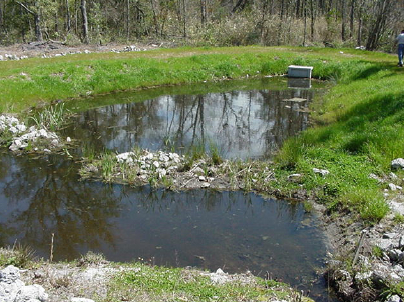
Wet Detention (Ponds and Lakes)
Stormwater
Combined Sewer Overflows
Wet detention is typically a constructed pond or lake, or it may be a pond or lake incorporated into a stormwater treatment system.
Routine maintenance of the pond includes mowing of the embankment and buffer areas and inspection for erosion and nuisance problems (e.g. burrowing animals, weeds, odors) (SEWRPC, 1991). Trash and debris should be removed routinely to maintain an attractive appearance and to prevent the outlet from becoming clogged. In general, wet detention ponds should be inspected after every storm event. The embankment and emergency spillway should also be routinely inspected for structural integrity, especially after major storm events. Embankment failure could result in severe downstream flooding. When any problems are observed during routine inspections, necessary repairs should be made immediately. Failure to correct minor problems may lead to larger and more expensive repairs or even to pond failure. Typically, maintenance includes repairs to the embankment, emergency spillway, inlet, and outlet; removal of sediment; and control of algal growth, insects, and odors (SEWRPC, 1991). Large vegetation or trees that may weaken the embankment should be removed. Periodic maintenance may also include the stabilization of the outfall area (e.g. adding rip-rap) to prevent erosive damage to the embankment and the stream bank. In most cases, sediments removed from wet detention ponds are suitable for landfill disposal. However, where available, on-site use of removed sediments for soil amendment will reduce maintenance costs.
Sediment control: A sediment forebay is highly recommended. Slopes: Side slopes of a permanent pool should not be greater than 3:1. Flatter slopes minimize bank erosion. Slopes leading to the pool should be less than 3:1. Inlet points should be designed with energy dissipaters to reduce inflow velocity. An emergency spillway should be included in the basin design. The basin should include a low-flow drain to assist in maintenance of the detention area. Sediment storage life span. Typically, in most areas, the 25-year sediment volume is calculated for the pond. Pond or lake depth: An average pool depth of 3 to 6 feet is recommended. Depths greater than 10 feet may have thermal stratification and anoxic conditions. Depths less than 3 feet increase sediment resuspension, water temperature, and algal blooms. Flow path: Maximize the flowpath length between the inlet and outlet. The length to width ratio should be at least 3:1.
Variable, depending on the size and amount of construction needed to create the lake or pond. Typical costs can be from $0.50 to over $1.00 per cubic foot (USEPA, 1999). Cost range reflects economies of scale based on the size of the pond, as well as pre-existing conditions.
Improve runoff control, including reductions of overall runoff from adjacent sites with proper design; Create wildlife habitat; Encourage community recreation facilities; Aesthetically pleasing; May increase property values. Requires significantly less expense for maintenance if natural vegetation is used along the banks.